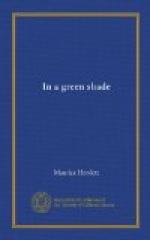Thou art not fair, for all thy red and
white,
For all those rosy ornaments
in thee,—
Thou art not sweet, though made of mere
delight,
Nor fair nor sweet—unless
thou pity me!
That first; and then this:
Shake hands for ever, cancel all our vows
And when we meet at any time
again,
Be it not seen in either of our brows
That we one jot of former
love retain—
and consider them for what they are: unapproachably beautiful, passionate, serious, on the edge of cynicism, but never over it. There you have the love of a young age of the world, when young men, hard hit, could be sharp-tongued, bitter, and often (though not in those two) too much in earnest not to be shameless. Agree with me, and see the men who sang and the women they sang of in preposterous stuffed and starched clothes which made them unapproachable except at the finger-tips, and yet burning so for each other that by words alone and the music in them they could rend all the buckram and whalebone and make such armour vain! You may see in Elizabethan dress a return to Art, as in Elizabethan poetry you see a return to Learning; but neither was designed to prevent a return to Nature; rather indeed to stimulate it. And so you come back to this:
Take thou of me smooth pillows, sweetest
bed,
A chamber deaf of noise and blind of light,
A rosy garland and a weary head ...
which is the perfectly-clothed utterance of an Elizabethan longing to be rid of his clothes.
I don’t propose to linger over the perruque. The Restoration was a time of carnival when, if the men were overdressed, the ladies were underdressed; and the perruque was a part of the masquerade. In such a figurehead you could be as licentious as you chose—and you were; you could only be serious in satire. The perruque accounts for Dryden and his learned pomp, for Rochester and Sedley, and for Congreve, who told Voltaire that he desired to be considered as a gentleman rather than poet, and was with a shrug accepted on that valuation: it accounts for Timotheus crying Revenge, and not meaning it, or anything else except display; it accounts for Pepys thinking King Lear ridiculous. Let me go on rather to the day of the tie-wig, of Pope’s Achilles and Diomede in powder; of Gray awaking the purple year; of Kitty beautiful and young, of Sir Plume and his clouded cane; of Mason and Horace Walpole. When ladies were painted, and their lovers in powder, poetry would be painted too. It would be either for the boudoir or the alcove. I don’t call to mind a single genuine love-song in all that century among those who dressed a la mode. There were, however, some who did not so dress.
Gray was not one. Whether in the country churchyard, or by the grave of Horace Walpole’s favourite cat, he never lost hold of himself, never let heart take whip and reins, never drowned the scholar in the poet, never, in fact, showed himself in his shirtsleeves. But before he was dead the hearts of men began to cry again. Forty years before Gray died Cowper was born; fourteen years before he died, Blake was born; twelve years before he died, Burns. It is strange to contrast the Elegy with The Poplar Field:




